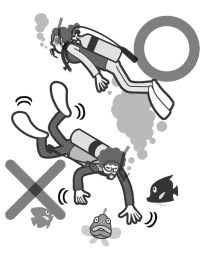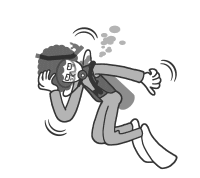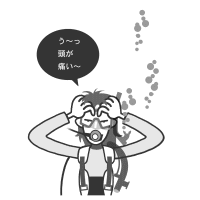
Nitrox specialty
Certification card
Medical check
Nitrox and air
Diving equipment for nitrox
Nitrox characteristic
Prevent oxygen poisoning 1
Prevent oxygen poisoning 2
Prevent oxygen poisoning 3
Health management
Dive plans and dive table
|

|
Amount of nitrogen
Nitrox contains less nitrogen than air, which is an advantage over air diving.
At the same dive depth, the amount of nitrogen that dissolves in the body during diving is smaller than that in the case of air, so the non-decompression limit is longer and your diving is safer for decompression sickness.
You may also think that nitrogen sickness may be reduced, but due to the anesthetic effect of high concentration oxygen gas, it may actually cause symptoms similar to nitrogen sickness.
|

Difference in the amount of nitrogen dissolved in the body |
|
Amount of oxygen
Nitrox contains more oxygen than air, so you can get more oxygen into your body by one breath when compared in the same breath.
This make you feel easier to breathe Nitrox than Air, and reduces breathing gas consumption during diving.
However you are required more attention than air diving about oxygen poisoning. |
 |
|
■Oxygen partial pressure
The respective pressures of oxygen and nitrogen contained in breathing gas are called partial pressures.
On land, we breathe air of 1 atm to live.
In this case, the partial pressure of oxygen in the air is 0.21 atm and the partial pressure of nitrogen is 0.78 atm.
Divers with a water depth of 10 m are diving by breathing 2 atm gas.
When breathing air, the partial pressure of oxygen in the breathing gas is 0.42atm(0.21atm×2) and the partial pressure of nitrogen is 1.56(0.78atm×2) atm.
On the other hand, EAN32 is Nitrox with an oxygen ratio of 32%, so if you breathe it on land, the partial pressure of oxygen is 0.32 atm and the partial pressure of nitrogen is 0.68 atm in Nitrox.
Also, when a diver with a depth of 10 m is breathing EAN32, the partial pressure of oxygen in the breathing gas is 0.64 atm and the partial pressure of nitrogen is 1.36 atm.
Thus, when using Nitrox, the partial pressure of oxygen in the breathing gas during diving will be higher than using air.
The oxygen partial pressure can be calculated by the following formula.
Oxygen partial pressure = Nitrox oxygen ratio × (Diving depth ÷ 10 + 1)
For example, when diving to a depth of 20 m using EAN32, the oxygen ratio of EAN32 is 0.32, so using the above formula you can caliculate Oxygen partial pressure as below.
Oxygen partial pressure = 0.32 × (20 ÷ 10 + 1) = 0.96
|
 Difference of breathing gas oxygen concentration |
|
■Oxygen poisoning
oxygen poisoning problem during leisure diving is central nervous system oxygen poisoning.
Deep depths and long diving where the absorption of oxygen into the body exceeds the specified level, diving with intense exercise where carbon dioxide tends to accumulate in the body, and diving in low water temperatures should be not done. |

激しい運動は× |
|
Also, if the regulator has a large resistance to breathing and it is difficult to breathe, or if you breathe shallowly and quickly, you will not be able to ventilate sufficiently, which increases the risk of oxygen poisoning.
Oxygen poisoning cause convulsions and you can no longer hold the regulator.
Symptoms such as dizziness, visual impairment (narrowing of the field of view), tingling and tightness of the lips or eyelids, nausea, and headaches are considered signs of oxygen poisoning.
Please stop the dive immediately. |
 |

Beware of dizziness and headaches |
|
|
|
  |
|

